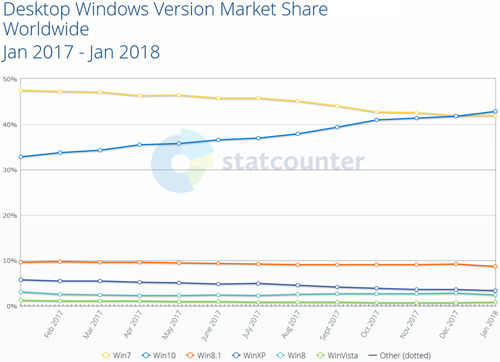Microsoft's Last Major OS Becomes Its Most Popular OS
Now that Windows 10 has surpassed Windows 7 for the first time in global usage statistics, it's not just the latest round of Microsoft's reigning OS passing the torch to the newest release. This time it marks the ascendance of the new model of Windows.
"This is a breakthrough for Microsoft," said StatCounter CEO Aodhan Cullen in a statement this month about the handover of the lead. StatCounter, a Web analytics company, tracks operating system, browser and screen resolution information for 10 billion visitors each month to more than 2 million sites worldwide.
Cullen is talking about Windows 10's January 2018 results as a breakthrough in terms of wresting control from Windows 7, which, like Windows XP before it, has proven to be an exceptionally sticky OS version for Microsoft.
In January, Windows 10 hit 42.78 percent share worldwide, compared to 41.86 percent for Windows 7. The worldwide milestone follows similar crossover points in the United Kingdom (June 2016) and the United States (January 2017).
 [Click on image for larger view.] Source: StatCounter
[Click on image for larger view.] Source: StatCounter
"Windows 10 was launched at the end of July 2015 and Microsoft will be pleased to have put its Windows 8 experience behind it. However, Windows 7 retains loyalty especially amongst business users. Microsoft will be hoping that it can replace it a lot quicker than XP, launched back in August 2001, which only fell below 5% usage worldwide in June of 2017," Cullen said.
Perhaps more significant, though, is that Windows 10's leading place asserts Windows as a Service, with rolling updates and an end to the old cycle of major launches every three years, as the mainstream version of Windows in the world.
There was a lot of hand-wringing about what exactly was meant when Microsoft officials called Windows 10 the "last major release" of Windows. It doesn't mean much in terms of new features or security patches, which continue to flood in, and at a much more rapid pace than in the old Windows model.
What it does mean is that once users are on Windows 10, they're supported for the life of their device, theoretically protecting them, Microsoft and the Internet at large from the kinds of security issues that have emerged and spread after a still-popular OS has fallen out of support.
The model could have been a failure. It could have followed in the footsteps of Windows 8, which also demanded a lot of adjustment from customers, who, in the main, refused Microsoft's directives.
Instead, Windows 10 -- and Microsoft's new approach to version support -- is the leading type of Windows by market share.
Posted by Scott Bekker on 02/07/2018 at 12:24 PM